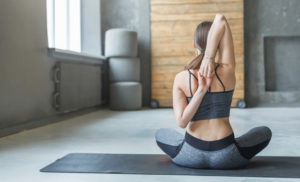
Improving flexibility through regular yoga practice boasts a number of tremendous health benefits including improved agility, range of motion, mobility, balance, better circulation, and less injury during daily activities or exercise. Looking to alleviate pain, improve physical performance, and state-of-mind? Increasing your overall flexibility can help you here too (1).
Improved flexibility is just one of the many benefits of regular yoga practice. One typically practices yoga to balance the body and mind and then enjoys improved strength and flexibility as well.
I enjoy practicing ,,yoga to destress and center myself, but I would also like to see improvements in strength and flexibility from my practice. If you’re anything like me, you might find yourself stretching regularly through yoga and some basic exercises and expect to see changes fairly quickly, only to become discouraged when progress slows.
In this post, I will share with you the top tips for increasing your flexibility fast without injuring yourself.
Practice often
I typically try to practice daily, but like most people, I do slip up. In order to really make a difference in your flexibility, you need to practice consistently. If you don’t think you can commit to daily practice, try for two to three times a week and keep it going. If you take a couple of weeks off you will notice a difference the next time you hit the mat.
This is definitely where I faltered. I would be really regimented about practicing daily for a while, then take a couple of weeks off and feel stiff as a board when I returned to my mat.
Stretch in the morning & evening
The morning stretch started as a personal hunch of mine. I always find that my body is stiffer in the morning and I can’t touch my toes, while I can accomplish this stretch easily in the afternoon or evening without a warm-up. I even avoided my morning practice because of this and opted for later windows in the day.
It turns out that lying in bed all night naturally makes your muscles stiffer, and loosening them up early in the day can really help improve flexibility, relieve sore muscles, decrease stress and anxiety, even improve digestion and ease headaches (2).
I also had a wonderful yoga instructor explain to me during one of our 6:00 am sessions that practicing in the morning was great for waking the body up and preparing to conquer the day.
By stretching again in the evening, you can unwind from the day, destress and prepare the body for sleep. A recent study from the Brazilian Journal of Psychiatry suggested the improved quality of sleep with stretching performed in the evening in conjunction with a regular exercise plan (3).
For best results in improved sleep, make ,,meditation part of your evening stretch.
By making time for a quick stretch in the morning and evening part of your daily habit, you will consistently improve flexibility and lengthen your muscles. You don’t have to commit to a full yoga practice twice daily, just choose a few key stretches you want to focus on for a while, and slowly lengthen the time of your stretching sessions as you wish.
Hold the stretch long enough
The optimal length of time to hold a stretch is a topic of much debate among experts in physiological health, but most agree that longer than 5 – 10 seconds is critical. Dr. Polly McGuigan, Senior Lecturer at the University of Bath and expert in the research of the neuromuscular system suggests holding the stretch for 30 seconds (4, 5). Other experts suggest the stretch should be held up to 90 seconds in order to change the substance in connective tissue and truly improve flexibility (6).
Don’t push the stretch too hard
You should feel the stretch, but it shouldn’t cause you pain. If any of your limbs start to shake, you are pushing it too hard. Going to this extreme could cause injury and prevent you from practicing for a few days or even weeks. We want to avoid this kind of injury which will not only hurt but put you back in your flexibility goals as well.
Breathe into the stretch
A good method to gently increase the stretch without causing pain is to breathe into the stretch by filling your lungs with air to feel a gentle increase in the stretch you are holding. On the exhale, see if you can reach just a tiny bit further. This is especially helpful in spinal twists and any forward folding stretch.
Try flexing
By flexing the muscle you are stretching during the stretch, but not as far as you can go – just short of your maximum stretch, you can send a signal to your brain that it’s safe to stretch the muscle a bit further. This is a practice called Proprioceptive Neuromuscular Facilitation (PNF) and it can result in rapid gains in flexibility (6).
Exercise before you stretch
Your muscles get warm and pliable during exercise, and it’s best to stretch after the activity. If you aren’t used to working out, walking can serve as an excellent form of exercise to warm up your muscles before stretching (7).
Stay hydrated
Muscles are made mostly of water and require a sufficient supply of water in order to work properly, so make sure you’re drinking at least eight – 8oz glasses of water each day. Your muscles need electrolytes too, including potassium, sodium, and calcium. If you feel you aren’t getting enough of these nutrients from your diet alone, consider sports drinks, an electrolyte supplement, or my personal favorite – smart water.
Get a massage
Massage can help loosen connective tissue in your muscles and allow them to stretch further and become more pliable. If you don’t have the time or budget to get a regular professional massage, you can achieve many of the benefits at home using a massage roller and various massage tools available to the public.
Try a warm bath
Taking a warm bath will relax and soothe sore muscles, which may help improve their flexibility as well. Even if this isn’t effective, who doesn’t enjoy a nice soothing bath anyway? The soothing effect you get from the bath will at least improve soreness and make you feel like you can get back to your routine quicker.
The bottom line
Improving your flexibility will enhance your health and well-being, and hopefully, these tips will help you get there. Ultimately, consistency is key so use the strategies you can commit to.
1 – ,,https://www.healthline.com/health/benefits-of-flexibility
2 – ,,https://www.theactivetimes.com/fitness/technique/reasons-why-you-should-stretch-morning
3 – ,,https://www.ncbi.nlm.nih.gov/pmc/articles/PMC6781703/
4 – ,,https://researchportal.bath.ac.uk/en/persons/polly-mcguigan
5 – ,,https://www.theguardian.com/lifeandstyle/2020/feb/23/five-ways-improve-flexibility
6 – ,,https://www.ncbi.nlm.nih.gov/pmc/articles/PMC3588663/
7 – ,,https://magnoliatherapyla.com/6-tips-improving-flexibility/
Improving flexibility through regular yoga practice boasts a number of tremendous health benefits including improved agility, range of mo… Read More
Read More







